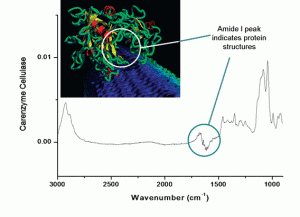Detergents in traditional washing machines rely on high temperatures and vigorous agitation in order to remove stains, which can contain a mixture of proteins, starches and lipids along with inorganic components. By using enzymes, the organic components in soiled fabrics can be broken down into smaller, easily soluble fragments and removed at lower temperatures with less mechanical energy and water consumption.
However, the enzymes currently being used in most current commercial formulations are fairly non-specific; combining a variety of enzymes capable of hydrolyzing a wide range of organic compounds. Considering that green surfactants also comprise of sugar or peptide base units there exists the strong possibility of these compounds demonstrating antagonistic interactions with the detergent enzymes, diminishing the overall effectiveness of the newly introduced bio-surfactant, enzyme or both and presenting a potentially significant hurdle in universally applying green surfactants in commercial applications.
While the general goal of the project is to identify this possible hurdle in the commercialization of green surfactants, the analytical approaches to this project will focus on understanding three fundamental aspects of the enzyme/surfactant interactions. 1) NMR, FTIR and HPLC to characterize the surfactant before and after introduction to the enzyme. 2) Florescence, Dynamic Light Scattering and Ultra centrifugation to observe the surfactant micelle formation while interacting with enzymes and 3) Surface tension measurements to study the surface activity of enzyme affected surfactants. 4) Enzyme activity tests: to understand the effects of bio-surfactants on enzymatic activity.

